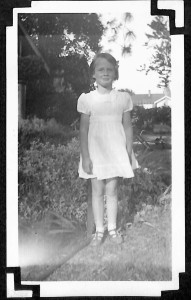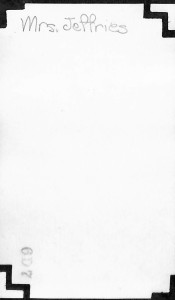When I was at the Brown family reunion the last weekend in June, I was given a bunch of old family photos that pertained to my branch of the family. Some were duplicates of ones I already had (from the big box of photos my mother gave me). Some I’d never seen before. I was delighted to receive them.
One photo in particular brought home an important lesson: Don’t take the labels on the back of photos as the gospel truth. When a picture has an identifying label I tend to assume that the label is accurate, in the absence of any information to the contrary. But that’s not necessarily the case.
I was given this photo of a little girl.
I know that it’s a photo of my mother, because I’ve seen many photos of my mother as a child. She also recognizes it as a photo of herself. My mother’s name when she was a girl was Betty Sue Brown.
This is what’s written on the back of the photo.
My mother’s grandmother was Alice Jeffries. I’m assuming that the label was some sort of direction to share the photo with Alice. But it sure seems like it’s identifying the photo, doesn’t it?
Now, I think most people would assume the girl in the photo isn’t married and therefore isn’t Mrs. Jeffries. But what if the label had said “Alice Jeffries” rather than “Mrs. Jeffries?” Then someone who didn’t know what my mother looked like as a child might assume the little girl in the photo was Alice Jeffries.
This is an important reminder to apply critical thinking when looking at photo labels. Don’t take them at face value; rather, try to find a few other clues to help verify the accuracy of the label, if you don’t know the people in the photos. In this example, Alice was born in 1885, so the attire in the photo would be a clue that it’s not a photo of her. Taking that extra step might help avoid misidentificaton.



There might be another reason for your mother’s grandmother’s name on the photo. I’ve seen photos of my Mom with her father’s name written on the back. The photo belonged to my great-grandmother and as she aged she kept track of which family which grandkids belonged to by writing the name of her kid that grandchild belonged to on the back. It helped her with her stories, “Now these are Clarence ‘s children…”
That’s a good point, Jo! Thanks so much for contributing that idea.
I love your advice of attacking the “backlog” incrementally, i.e., in short blocks of time. When my mother died a few years ago, I got all her albums and family pictures. It has been an ongoing project to get these organized. Some things that are working for me along with your good advice are passing pictures of friends along to their families (this has been extremely well received); also, I am making folders related to specific times in my parents’ lives. An example of this : I found a lot of pictures from my father’s college days so I made a “Dad – UF” file. I am being somewhat ruthless in throwing away pictures that do not appear to be my family and are not identified on the backs. This is simplifying the process for me. Again, thanks for all your help and the great discussions on your blog.
Thanks, Elizabeth! I love the idea of organizing the family photos under times of your parents’ lives. This is what I often recommend when I’m working with clients on their more recent photos. Things don’t have to be in a strict chronology, just in categories that make sense, in my opinion. Thanks for your kind words about the blog!